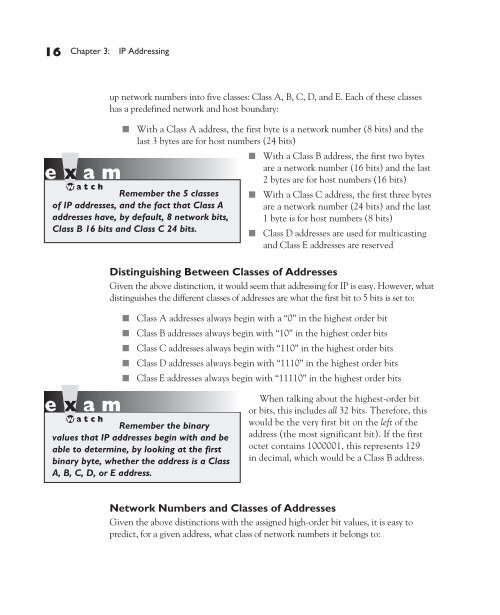ch03 IP Addressing.pdf - The Cisco Learning Network
ch03 IP Addressing.pdf - The Cisco Learning Network
ch03 IP Addressing.pdf - The Cisco Learning Network
You also want an ePaper? Increase the reach of your titles
YUMPU automatically turns print PDFs into web optimized ePapers that Google loves.
16 Chapter 3: <strong>IP</strong> <strong>Addressing</strong><br />
up network numbers into five classes: Class A, B, C, D, and E. Each of these classes<br />
has a predefined network and host boundary:<br />
■ With a Class A address, the first byte is a network number (8 bits) and the<br />
last 3 bytes are for host numbers (24 bits)<br />
■ With a Class B address, the first two bytes<br />
are a network number (16 bits) and the last<br />
2 bytes are for host numbers (16 bits)<br />
Remember the 5 classes<br />
of <strong>IP</strong> addresses, and the fact that Class A<br />
addresses have, by default, 8 network bits,<br />
Class B 16 bits and Class C 24 bits.<br />
■ With a Class C address, the first three bytes<br />
are a network number (24 bits) and the last<br />
1 byte is for host numbers (8 bits)<br />
■ Class D addresses are used for multicasting<br />
and Class E addresses are reserved<br />
Distinguishing Between Classes of Addresses<br />
Given the above distinction, it would seem that addressing for <strong>IP</strong> is easy. However, what<br />
distinguishes the different classes of addresses are what the first bit to 5 bits is set to:<br />
■ Class A addresses always begin with a “0” in the highest order bit<br />
■ Class B addresses always begin with “10” in the highest order bits<br />
■ Class C addresses always begin with “110” in the highest order bits<br />
■ Class D addresses always begin with “1110” in the highest order bits<br />
■ Class E addresses always begin with “11110” in the highest order bits<br />
Remember the binary<br />
values that <strong>IP</strong> addresses begin with and be<br />
able to determine, by looking at the first<br />
binary byte, whether the address is a Class<br />
A, B, C, D, or E address.<br />
When talking about the highest-order bit<br />
or bits, this includes all 32 bits. <strong>The</strong>refore, this<br />
would be the very first bit on the left of the<br />
address (the most significant bit). If the first<br />
octet contains 1000001, this represents 129<br />
in decimal, which would be a Class B address.<br />
<strong>Network</strong> Numbers and Classes of Addresses<br />
Given the above distinctions with the assigned high-order bit values, it is easy to<br />
predict, for a given address, what class of network numbers it belongs to:

















